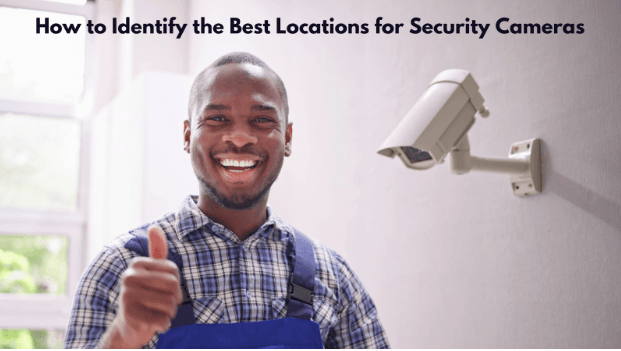The security of personal and commercial properties is increasingly important in today’s world. With advancements in technology, the use of security cameras has become one of the most reliable methods to deter and solve crime. According to industry estimates, over 1 billion surveillance cameras will be installed globally by the end of 2021, underscoring the widespread acknowledgment of their importance in modern security strategies.
Whether you’re looking to enhance the security of a residential complex or a commercial property, the insights provided here will help you make informed decisions to effectively safeguard your premises. This blog delves into the critical aspects of assessing security needs, identifying strategic locations for camera installation, and understanding the technological and legal issues involved.
Assessing Your Security Needs
Before installing any security cameras, it’s vital to conduct a thorough security audit to determine your property’s specific needs. This process involves identifying vulnerable areas where your property is most susceptible to breaches.
Consider factors such as previous security breaches, the layout of your property, and general security concerns in your area. This targeted assessment allows you to tailor your security measures effectively, ensuring that you deploy cameras in the most beneficial spots to enhance your safety measures.
Identifying the best locations for security cameras is essential to maximizing coverage and ensuring property safety. Begin by assessing vulnerable areas, including entry points, parking lots, and blind spots, to determine where surveillance is most needed. For businesses, strategically placing commercial security cameras in high-traffic areas and near valuable assets helps deter theft and monitor activity effectively. Consider the field of view, lighting conditions, and potential obstructions when selecting installation sites to ensure optimal performance.
Key Areas for Camera Placement
Entrances and Exits
The primary entry and exit points of your property should always be monitored. This includes front and back doors, garage doors, and any gateways. Cameras in these locations document activity and control access, aiding both prevention and investigations.
Windows
Windows, particularly those hidden from street view or on the ground floor, are common entry points for intruders. Positioning cameras to monitor these areas helps in the early detection of any unauthorized entry attempts, significantly increasing the security of these vulnerable spots.
Common Areas
Common areas within a building, such as hallways, living rooms, staircases, or shared facilities in condominiums, are crucial spots for surveillance. Cameras in these areas help monitor movement and can be key in tracking the activities of intruders within the premises.
Perimeters
Perimeter surveillance is essential for detecting trespassers before they even attempt to enter a building. Cameras covering the perimeter can act as a deterrent and provide valuable information about suspicious activities around the boundaries of your property.
Consideration of Camera Angles and Field of View
Choosing the right camera angles is essential for maximizing surveillance effectiveness. Cameras should be placed to avoid blind spots, ensuring a wide coverage area. A proper field of view for a camera can vary, but typically, a single camera can cover anywhere from 70 to 90 degrees.
Strategically positioning cameras to overlap in coverage can prevent blind spots, providing comprehensive surveillance of the area. This careful planning in camera placement enhances the capability to capture events crucial for security monitoring and evidence gathering.
Height and Mounting of Cameras
The height at which cameras are mounted plays a critical role in their effectiveness. Ideal mounting heights range from 8 to 10 feet above the ground. This elevation is high enough to reduce the risk of tampering and low enough to capture clear, identifiable images.
Consider the types of mounts that best suit each location—wall mounts, ceiling mounts, or even hidden mounts for more discreet surveillance needs. Proper mounting not only secures the camera but also ensures that it has an unobstructed view of the area it is intended to monitor, optimizing the quality and usefulness of the footage collected.
Obstructions and Environmental Factors
When installing security cameras, it’s essential to consider potential obstructions that could impair visibility and effectiveness. Common obstructions include trees, outdoor decorations, or architectural features of a building. It’s crucial to adjust the placement of cameras to avoid these barriers, ensuring a clear line of sight.
Additionally, environmental factors such as weather conditions need to be considered. For instance, cameras should be protected against elements like rain, snow, and extreme temperatures, which might require weatherproof housings or protective covers to maintain functionality and prolong the life of the cameras.
Lighting and Visibility
Adequate lighting is paramount for capturing high-quality video footage, especially in low-light conditions or during the nighttime when most security breaches occur. For areas with poor lighting, consider installing cameras equipped with infrared (IR) night vision capabilities or adding supplementary lighting sources.
This can improve the visibility and effectiveness of your surveillance system. Cameras with built-in IR provide the ability to see clearly in complete darkness, which is crucial for continuous monitoring and ensuring no activities go undetected.
Legal Considerations
It’s imperative to understand and comply with local privacy laws when installing security cameras. These laws often dictate where cameras can be placed, especially concerning pointing cameras towards public spaces or neighboring properties. Infringing on others’ privacy can lead to legal repercussions.
Always ensure that your camera placements respect the privacy of others and are in strict compliance with all local and national laws. It’s advisable to consult legal advice to navigate the complexities of surveillance law to prevent any potential legal issues.
Technology and Connectivity
In today’s digital age, the connectivity of security cameras offers enhanced flexibility and monitoring capabilities. Modern security systems often feature network connectivity that allows for remote viewing and management through smartphones or computers. This connectivity enables property owners or security personnel to monitor live feeds from anywhere, enhancing security responsiveness.
Additionally, advancements in technology have introduced features like motion detection, facial recognition, and automatic alerts, which can provide real-time updates and notifications about security events, making surveillance more proactive rather than reactive.
Professional Consultation
While DIY security camera installation is possible, consulting with a professional installer can provide numerous benefits. Professionals can offer expert advice on the optimal placement of cameras, taking into consideration all the factors discussed from environmental influences to legal restrictions. They are also equipped to integrate the latest technology effectively and ensure that your system is set up for maximum coverage and efficiency.
A professional installation ensures that the system is correctly configured from the start, potentially saving time and money on future maintenance or reconfiguration and often enhancing the overall effectiveness of your surveillance system.
Conclusion
The strategic placement of security cameras is an essential aspect of a security plan. By carefully assessing your security needs and considering the layout of your property, you can effectively determine the most critical areas for camera installation. Consulting security professionals significantly improves camera installation and effectiveness.
Remember, the goal of a well-designed security camera system is not just to record criminal activity but to deter it altogether. Regularly evaluate and adjust camera placements to meet evolving security needs and maintain an effective system. Stay proactive, stay informed, and continue to prioritize the safety of your property and its inhabitants.
Frequently Asked Questions
What is the best type of camera for outdoor use?
Weather-resistant models with night vision capabilities are recommended for enduring external environments.
How can I ensure my cameras are tamper-proof?
Using secure mounts and positioning cameras out of easy reach helps significantly deter vandalism.
Is it legal to point a security camera at a neighbor’s property?
It’s generally advisable to avoid capturing footage beyond your property line to prevent privacy violations.

















